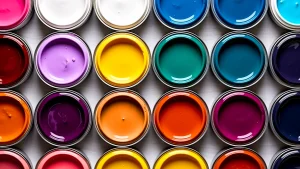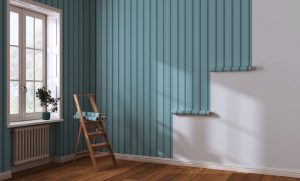Understanding the interplay between lighting and paint choices is crucial for any interior design project. Lighting can dramatically alter the appearance of paint colours, affecting how they are perceived in different settings.
Whether it’s the warm glow of a sunset or the bright intensity of midday, natural light can transform the mood of a room by shifting the hues of the walls. Similarly, artificial lighting, such as LED or fluorescent lights, can enhance or distort paint colours, making the selection process a pivotal part of achieving the desired aesthetic and functional results.
Choosing the right paint colour without considering the lighting is akin to picking an outfit in the dark—it might look good in theory, but the reality can be unexpectedly different.
This blog delves into the nuances of how different types of lighting impact your colour choices, offering insights and tips to help you make informed decisions that will stand the test of changing light throughout the day and night.
Types of Lighting
Natural light is a dynamic and unpredictable source of illumination that varies not only throughout the day but also with the changing seasons. North-facing rooms can seem cooler and require warmer tones to balance the lack of direct sunlight, whereas south-facing rooms benefit from brighter, more vibrant colours that can stand up to intense light.
Understanding these nuances can guide your paint selection process effectively.
Artificial lighting, on the other hand, is within our control and can be tailored to enhance or mute certain tones in the paint. Different bulbs emit varying colour temperatures and intensities—incandescent bulbs create a warm, yellowish hue, while LEDs can range from cool to warm white, influencing the wall colour they illuminate.
When considering artificial light, it’s essential to think about the purpose of the room and the mood you want to create. Fluorescent lighting, often used in offices and kitchens, has a very different impact compared to the soft ambient light of an LED lamp in a living room.
Each type of light interacts differently with paint colours, sometimes deepening hues and other times washing them out. Selecting the right paint colour thus becomes a strategic decision, depending on the primary light sources in the space.
Choosing Paints for Different Lighting Conditions
Selecting paints for rooms with low natural light involves considering brighter or lighter colours to make the space feel larger and more open. Pale hues can reflect artificial light effectively, enhancing the room’s overall brightness without the benefit of substantial sunlight.
On the other hand, rooms flooded with natural light have the luxury of accommodating darker or more saturated colours without the fear of the space feeling small or cramped.
For spaces that serve multiple purposes or experience significant changes in lighting throughout the day, it’s wise to choose colours with a neutral base.
These hues adapt more fluidly to varying lighting conditions, maintaining consistency in appearance under different light sources.
Testing paint samples in the room intended for redecoration at different times of the day is also a practical step. This approach allows you to observe the interplay between light and colour directly, ensuring the final selection complements all lighting conditions present.
Lighting and Colour Psychology
The psychological impact of colour is well-documented, influencing mood and emotional responses. Lighting can significantly alter this impact by changing the intensity and depth of colours. For instance, a blue room can feel soothing under soft light but may seem cold or unwelcoming under stark fluorescent lighting.
Understanding these effects can help in selecting the right colour to achieve the desired psychological effect in a room.
Moreover, combining lighting and colour strategically can enhance or moderate these psychological effects. Warm lighting can make reds and yellows more vibrant, evoking feelings of warmth and energy, ideal for living spaces or dining areas. Conversely, cooler lighting can make blues and greens appear more serene, perfect for bedrooms or offices where calm and focus are desired.
Tailoring your paint and lighting choices to support the psychological goals of each room can significantly enhance the functionality and emotional appeal of the space.
Conclusion
The relationship between paint colours and lighting is a complex but crucial aspect of interior design. As we’ve explored, lighting conditions can transform the appearance of colours, affecting everything from spatial perception to emotional responses.
By understanding the types of lighting and how they interact with different paints, you can make more informed decisions that ensure your chosen hues look as intended, regardless of the time of day or type of light.
In conclusion, thoughtful consideration of how lighting affects your paint choices will not only enhance the aesthetic appeal of your space but also its overall functionality.
If you are unsure whether to paint yourself or hire professionals, read our other blog here.
Whether adjusting for natural fluctuations in daylight or compensating for the limitations of artificial light, your approach to this interplay is key to creating a harmonious and appealing environment.
Get in touch with us today if you are looking for painting and decorating services.







